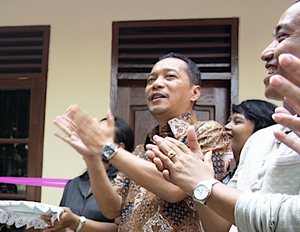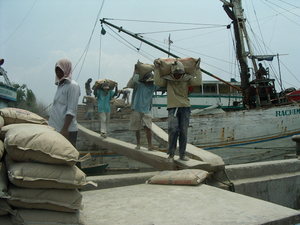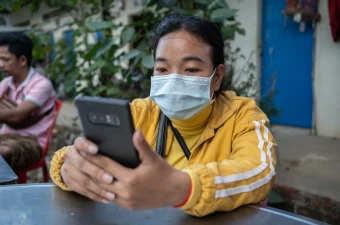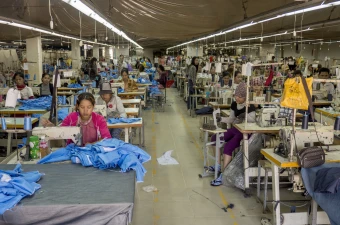Existing social protection schemes tend to be fragmented and scattered in Indonesia. Following widespread lobby and actions for protection by the labour unions, the Indonesian government finally decided to extend social security.

Gradually the entire population will be covered in case of illness, work injury, old age, and death of the breadwinner.
Rekson Silaban, of CNV Internationaal's partner organisation KSBSI, explains the government approved the introduction of 5 social security schemes from 1 July 2015, following pressure after a lawsuit and widespread demonstrations organised by the KAJS. This Committee for Social Security comprises 66 labour unions, student associations and NGOs.

Rekson Silaban, SBSI Indonesia
The Indonesian Constitution recognizes the right to social security for all and the responsibility of the government in the development of social security policy, since 2002. However the Cabinet of President Susilo Bambang Yudhoyono seemed reluctant to pass the Social Security Law since 2004. Now the government however is making real progress in reaction to the pressure following a lawsuit and widespread demonstrations.
Unions argue there is no obstacle for Indonesia to introduce universal health protection. The country has grown to become a middle-income country. More precisely, the 17th World’s largest in terms of GDP. Indonesia is achieving economic growth of 6-7% annually, even during the global economic crisis!
The unions’ struggle involved millions workers from all over the country. A big number of rallies, meetings, and lobbying opportunities has been organized. The Unions were fortunate that Indonesia’s democratic atmosphere allows unions to organize rallies, speak freely to media, and get support and recognitionfrom various stakeholders.

A milestone for Indonesia's labour movement
This is why many observers say this is a milestone for Indonesia’s labour movement. In supervising the implementation of the new social security system, the Unions were placed as a reliable part in the social security’s tripartite supervisory body. Through this supervision body, the Unions are expected to have a daily formal information channel to make sure that social security is run as effectively as possible.
In general terms, Indonesia introduced a three-pillar social security system, namely:
- Social assistance/service. This system is funded by the State. Beneficiaries are old and poor people, schools, and micro-business grants
- Compulsory savings. Everyone is required to pay into a provision fund to benefit from a public pension
- Social insurance. Everyone makes contributions or pays a premium, which is compulsory. For poor people, the health care premium is paid by the government.
An important milestone is the progressive implementation of the National Social Security Law (Law No. 40/2004 regarding the National Social Security System). The law mandates the extension of social security coverage to the whole population in the categories of health, work injury, old age, and death of the breadwinner. The Law applies non-contributory schemes for the poor, contributory schemes for the self-employed and statutory social security schemes for formal sector workers.
The Law on Health Social Security Providers (No. 24/2011), elaborates the implementation of the National Social Security System. It stipulated the universal health insurance to commence in 2014. Work injury, old age, and death insurance are anticipated to start in 2015.
Coverage is gradually extended
The Social Health Insurance Provider (BPJS Kesehatan) is officially in operation since 1 January 2014. BPJS Kesehatan is tasked with providing health insurance to the whole population, through contributory and non-contributory schemes. It is expected to gradually extend coverage and reach universal coverage by 2019. The Workers’ Social Security Provider (BPJS Ketenagakerjaan) is preparing to launch in 2015.
Until the National Social Security System is fully operational, the social protection system principally comprises statutory social security schemes for formal workers and a tax-financed social assistance system (public welfare) as part of a broader set of antipoverty programmes and government subsidies.

Improving coverage among the poorest and most vulnerable
Alongside the development of the National Social Security System, extension is also taking place on the social assistance front. The aim is to improve coverage among the poorest and most vulnerable.
Various national and local-level social protection programmes for different target groups exist in the country. These programmes, however, tend to be fragmented under different ministries and at different government levels where improved coordination is called for.
The main reforms of social security in Indonesia
Under the law 24/2011, there are at least 4 main changes:
- An additional program from 4 to 5 schemes.
- The government’s commitment to have universal medical care to the whole population, in which the government will pay the contribution of poor people.
- Flexibility of the law to cover the informal economy and the self-employed.
- To simplify the social security institution.
There will be only two public independent institutions that will run the social security. Namely the social security for healthcare, and the employment social security.
Starting from 1 July 2015, these institutions will implement the new law. Healthcare is intended to cover all employees and residents (including foreign residents after 6 months of work) under a single health care system. The employment social security (BPJS Ketenagakarjaan) will administer some employment benefits, which include three new schemes:
- elderly care,
- workplace accident insurance
- death insurance and pension
Both laws were enacted after the severe financial crisis, which warned countries about the crucial need for a social security system to overcome financial catastrophes.
All healthcare coverage under Askes (for civil servants), Jamsostek (for the private sector) and Asabri (for the police and army) were transferred to BPJS Health Care on 1 January 2014.So
Social security for 250-plus million people
Both BPJS entities will be non-profit public entities, marking a significant change from the current structures, which are for-profit, state-owned enterprises.
The following existing institutions run social security schemes, but will transform during the period 2014-2019:
- PT Persero Asuransi Sosial Angkatan Bersenjata Indonesia (PT ASABRI Persero) is a State-owned enterprise or Persero that runs old-age benefits (saving scheme and pension) for armed forces, police personnel and civil servants employed in Military and Police Offices.
- PT Persero Tabungan dan Asuransi Pensiun (PT TASPEN Persero) is a State-owned enterprise or Persero that runs old-age benefits (saving scheme and pension) for civil servants.
- PT Persero Jaminan Sosial Tenaga Kerja (PT JAMSOSTEK Persero) is a State-owned enterprise or Persero that runs old-age benefits (provident funds), death benefits, healthcare and maternity benefits, and workplace accident benefits for private employees. PT JAMSOSTEK also runs voluntary schemes for employees in the informal economy.
- PT Persero Asuransi Kesehatan Indonesia (PT ASKES Persero) is a State-owned enterprise or Persero that runs healthcare and maternity benefits for civil servants, government pensioners, military and police pensioners, as well as veterans.

Extension of social security to informal workers
The previous social security system, which only served the formal workers, was highly criticised. Marginalized informal workers compose of majority workers, and the new law opens the door for informal workers and the self-employed to be covered by social security. For health and medical protection – unless they are poor, in which case the government takes care – there are three options.
- For third class hospital service they pay Rp 22,500.- (USD 2) per month
- For second class services, a monthly contribution Rp 44,500 (USD 3,8)
- For first class services, they pay Rp 55,000 (USD 4,5).
These three options can accommodate 4 persons (e.g. wife/husband and two children).
For practical administration reasons there are two models of membership. First, a worker can apply individually to be member of the social security, and for a group insurance they can apply as group. This regulation puts under manpower the ministerial decree 5/2013.
In Indonesia there are around 54 million paid informal workers. In the new law this number will increase significantly due to the flexibility of its application. Meanwhile, the number of active formal workers contributing to social security in 2013 were 17 million. This number is still far low from the total of 44 million formal workers. But since the new law was introduced, is it foreseen a number of fines to those enterprises that do not comply with the law, and it is expected that this situation will increase in coming years.
Contribution and benefits of the social security for formal workers
The total contribution by the employer and the employee is predicted to be of around 19%/month. This means an increase from the previous, which required a maximum of only 13%.
From July 2015 there will be 5 social security schemes in Indonesia, namely;
- Occupational accident scheme, with a contribution of between 0,24% to 1,74% depending on the type of business. The contribution is paid by the employer.
- Death benefit, with a contribution is 0.3% paid by employers.
- Old-age benefit scheme of 5.7% (3.7% paid by the employer; and 2% by the employee)
- Healthcare protection scheme of 5% (4% paid by employer, 1% paid by employee)
- Pension scheme (still under negotiation). The last proposal was of 8% (4% paid by the employee and 4% by the employer)
Related news on CNV Internationaal's projects in Indonesia
CNV Vakmensen - committed to vulnerable outworkers in Indonesia
10 million Indonesian Domestic workers demand labour rights
Publication date 18 05 2015


